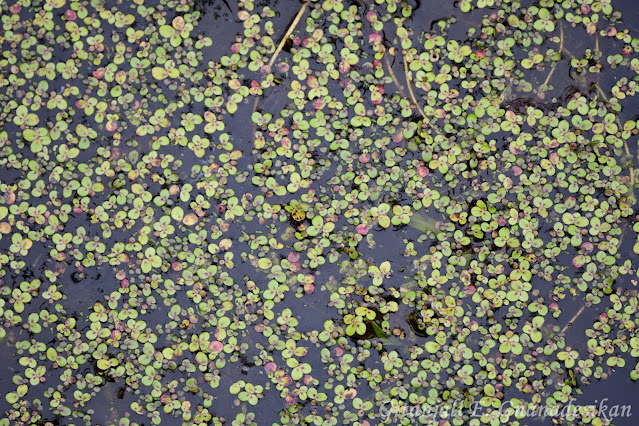This cute little northern watersnake (Nerodia sipedon sipedon) was curled up on this log.
Here it is again zoomed out, for a sense of scale.
I thought this eastern painted turtle (Chrysemys picta picta) was doing a good job of showing off why they are called "painted". Look how the red extends down onto the foot!
Meanwhile, this snapping turtle (Chelydra serpentina) was not at all demonstrating its snapping, but was simply browsing on various aquatic vegetation.
I also saw a "green frog" (Lithobates clamitans)...
And a lovely bright green "American bullfrog" (Lithobates catesbeianus).
There were red-winged blackbirds (Agelaius phoeniceus) galore, and many of them seemed to be feeding young nestlings in well hidden nests.
There were also a lot of eastern phoebes (Sayornis phoebe) ...
Several gray catbirds (Dumetella carolinensis) chattering away...
And the blur of an American redstart. I actually saw a few of them, but this blurry photo was the only one I managed to get, thankfully enough to confirm my identification!
Mammals were comparatively scarce, but I saw a couple eastern chipmunks (Tamias striatus, a different species from the chipmunks in Arizona), including this cute little one who dashed towards me across one of the boardwalk bridges.
Also spotted on the boardwalk, this common whitetail (Plathemis lydia) was eating another insect, as dragonflies do.
I was excited to see several little stands of ghost pipe (Monotropa uniflora). For those not familiar, ghost pipe is not—despite appearances—a fungus, but a plant. Unlike most plants, though, it doesn't have any chlorophyll, and so is white instead of green. Instead of harvesting its energy from the sun, it is parasitic on certain types of fungi that live in the roots of trees.
Speaking of fungi, I also saw this unidentified mushroom (maybe a beech rooter, Oudemansiella furfuracea??).
Of course, there were a variety of interesting aquatic and non-aquatic plants as well, and I tried to document a few of them, including this green arrow arum (Peltandra virginica)
Have you ever looked at a pond and seen these little leaves everywhere? This is duckweed. Specifically, I think it is greater duckweed (Spirodela polyrhiza).
And these iconic yellow pond-lillies are, I think, spatterdock (Nuphar advena).
Looking across a large area of reeds, I was surprised to see a yellow iris (Iris pseudacorus) poking out. While it was certainly pretty, apparently they can be invasive in American wetlands.
Purple crownvetch (Securigera varia) is also a pretty but invasive flower.
Ferns are something I sometimes forget that I miss in Tucson until I see them...either up a mountain somewhere in Arizona, or elsewhere. And then they make me smile. I've tried occasionally to grow one indoors, but it's hard to keep them moist enough! I think this is a wood fern (Dryopteris), but I'm not sure what kind.
Finally, this was the view through one of the wildlife blinds. I didn't see much there beyond a few blackbirds, but I drank in all the lovely green.
If you're in the area, I definitely recommend stopping by The Great Swamp!




























No comments:
Post a Comment
Thoughts, reactions, or comments? I always love to hear from you!